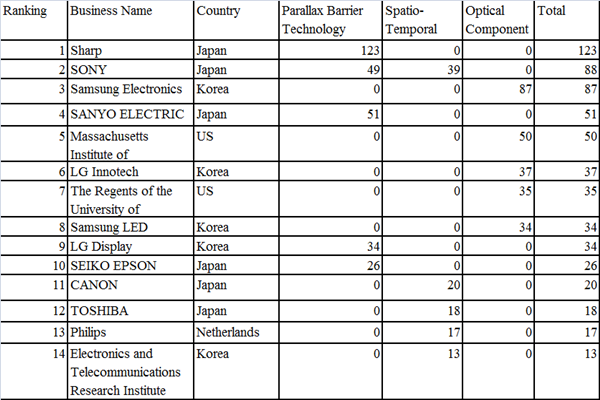Interests on optical components that are used on next-generation are rising.
According to ‘2014 National Patent Strategy Blueprint Report’ that was co-published by Korean Intellectual Property Office and Korean Intellectual Property Strategy Institute, 3 areas of optical components that materialize variety of 3D images were chosen as future promising technologies. There are 3 technologies: ‘Parallax Barrier Technology’ that uses 3D display, ‘Spatio-Temporal Multiplex Technology’ that is applied on hologram signal processing, and ‘Optical Components that Materialize High Color Saturation’ that materializes display high-definition. These technologies are all technologies for optical components that will be applied on next-generation displays and they are currently at introduction stage.
Currently optical component for display technologies’ developments are centered on technologies such as element technology that uses linear and circular polarization element, Lenticular Lens optical component that uses afterimage effect and polarization switch, and lenses for integral image that materialize natural 3D-effect.
Interests on optical components are continuously increasing as it is expected that display technology’s progress will be centered hereafter on materialization of natural 3D image and minimization of eyes’ tiredness.
Patent application related to display optical components is very active as expected. Continuous application is happening after 2009, and it is predicted that this trend will continue for awhile. Patents regarding optical components are led by 3 promising technologies: Parallax Barrier, Spatio-temporal multiplex, and materialization of high color saturation.

The U.S. is leading in developing technologies in current display optical component field, and Korea, Japan, and European companies are following the U.S. Sharp has the most applied patents at 123 if one were to look at it per company. Sony (88) and Samsung Electronics (87) are second and third respectively, and MIT and University of California also have many related patents. Within Korean companies other than Samsung Electronics, LG Innotec, Samsung LED, LG Display, Electronics and Telecommunications Research Institute, and etc. have 10 or more related patents.
Looking at per technology, Sharp, Sanyo, Sony, and LG Display are leading in developing technologies in Parallax Barrier field. Sony, Canon, Toshiba, Electronics and Telecommunications Research Institute have many patents related to spatio-temporal multiplex technology. Samsung Electronics has the most patents in optical components that materialize high color saturation field, and MIT and LG Innotec follow Samsung Electronics.
Number of lawsuits regarding patents related to optical components for next-generation display is slowly increasing. It is analyzed that there is a high possibility that dispute might occur in spatio-temporal multiplex technology field especially. Total of 4 lawsuits occurred through Non-Practicing Entity (NPE). NPE’s number of secured patents in Parallax Barrier technology and optical components that materialize high color saturation field is also gradually increasing. Especially Taiwan’s ITRI that attacked Korean companies numerous times has many patents in both fields, which increases the possibility of start of lawsuits.
*Detailed information can be found on IPnomics’ homepage (www.ipnomics.co.kr).
Staff Reporter Lee, Kangwook | wook@etnews.com